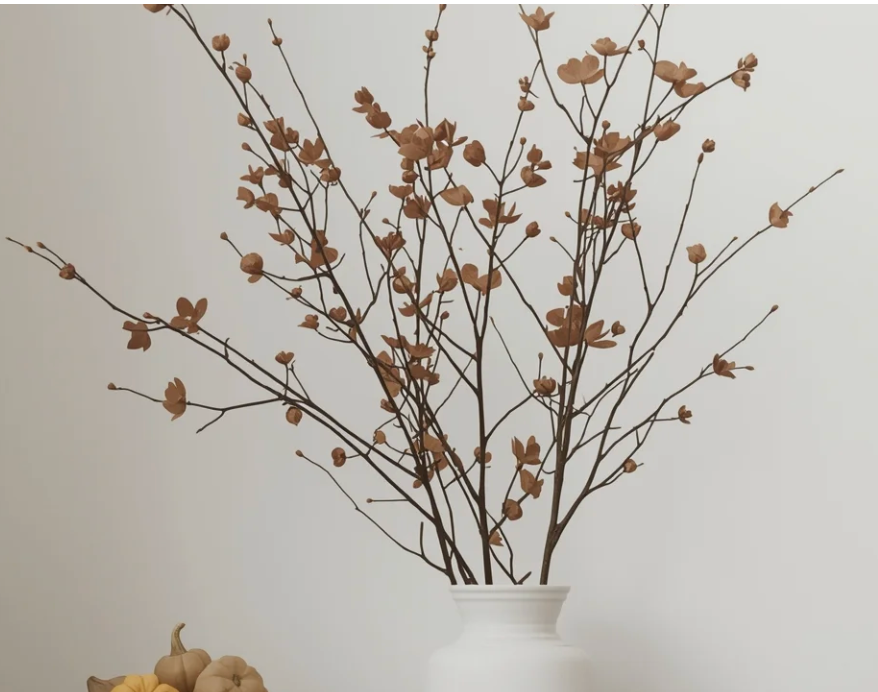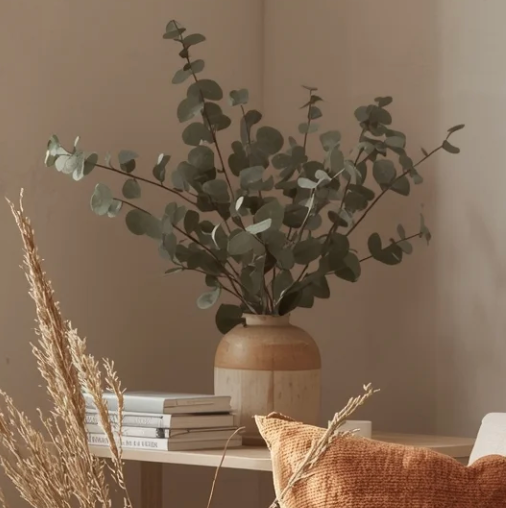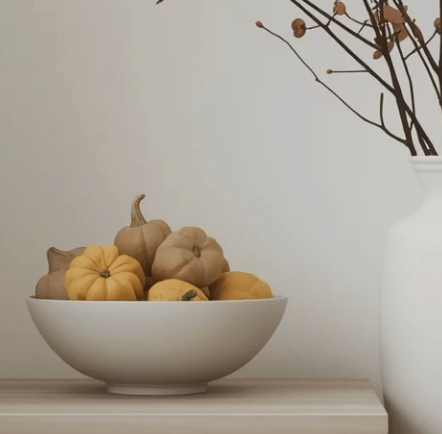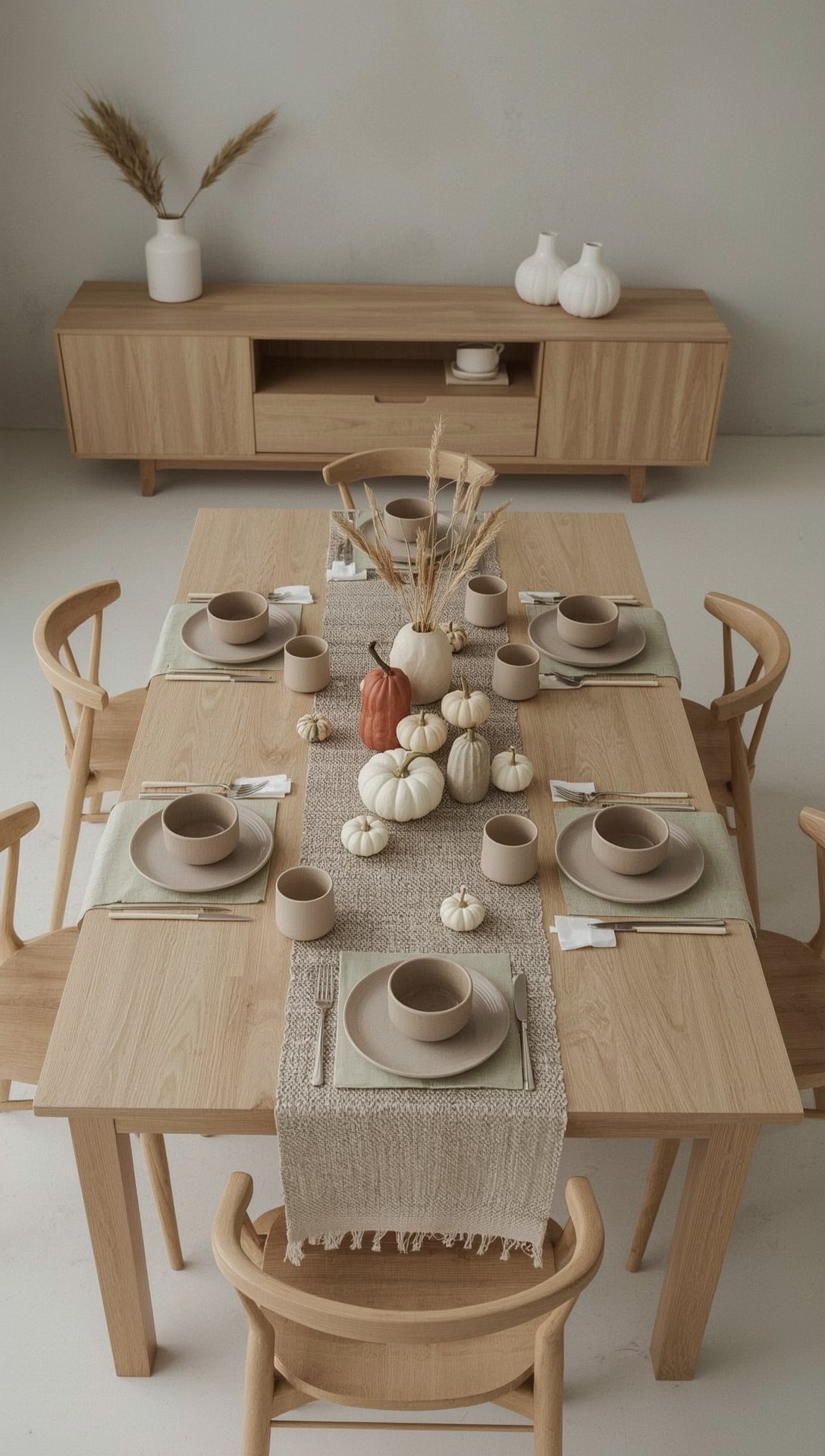Thanksgiving Decorating Ideas: Elegant, Minimalist and a Serene Japandi Harvest
Looking for Thanksgiving decorating ideas that isn’t noisy, maybe try Japandi fall style. Japandi mixes Japanese simple feel with Scandinavian cosy vibe.
It leans on wabi sabi – the idea that imperfect things can be beautiful – then dresses it in warm, soft textures. The result may mean an elegant yet personal setting, not too heavy. Whether a host prefers minimal, classic, or mixed taste, this approach seems to fit. Small details, like raw wood bowls or linen runners, bring real material depth.
Designer tricks may involve less is more, focusing on intention over clutter. Overall, space feels fresh, calm, ready for family gathering. You could place a pumpkin slice centerpiece or candles that flicker softly. Those choices may add warm tone without crowding the view.
Main Ideas: Your Japandi Principles for Thanksgiving

To get this look right, we root our decorating choices in the main ideas of Japandi design, which value calm and authenticity:
Wabi Sabi (Japanese Minimalism)
At its core Japandi leans on wabi sabi, a Japanese thought that respects flaws, change and the natural look of real things. In a room that follows this, you’d pick what feels real‑hand made – a pot that’s a little rough around the edge, a wooden bowl with a natural grain, or a linen napkin that shows tiny stitches. It’s definitely quality over quantity; one nice vase works better than a heap of cheap trinkets. The colors stay soft, not shiny. For Thanksgiving you might put a handful of dried branches in a matte pitcher of apple cider. The feeling is quiet reverence. Guests can see the wood grain, feel the clay, smell the earth.
Hygge (Scandinavian Warm Feel)
Hygge adds the warm part of the mix. It isn’t a visual rule so much as a feeling you build with light and soft things. Think: a few unscented candles on a mantle giving a soft amber glow, an armchair with a big fluffy throw that invites you to sit and talk. Soft fabrics matter – a knit blanket, a sheepskin pillow or a rug made of natural fibers add layers of comfort that soothe the clean edge of wabi‑sabi. The space ends up a calm talk between looking at something calm and feeling snug.
Mono no aware (Feeling The Moment Pass)
The third idea is mono no aware, the Japanese love of things that fade. Autumn, with its leaves falling and days getting short, fit this feeling perfectly. Using things like fresh harvest ingredients or dried flowers that show off a moment in time honors the season beautifully, emphasizing the natural decor needed for the holiday.
Getting the Minimalist Harvest Look
The first rule of Japandi Fall Decor is restraint. Instead of stuffing every surface with bits, leave blank space so each piece can breathe. A clean wood board with a few dried gourds, a single woven basket of pears, or a thin slate plate with a couple of rosemary stems can show plenty without clutter. The goal is a peaceful vibe, letting eyes wander and the mind settle. Holding back does not make the day any less festive; it actually makes each chosen piece count more, matching the spirit of thanks.
The Secret to Subtlety and Quality for Thanksgiving
The Japandi way is about making thoughtful choices, which perfectly matches expert advice for Thanksgiving decorating ideas. The main rule is to focus on quality over quantity. Choose items that feel solid – a hand carved ceramic bowl, a linen runner with a neat weave, a brass handed knife. When you put these on the table each one pulls attention because it feels well made, not because it screams loud. The secret is in the look and feel of each item; a wooden spoon tapping a porcelain mug can be a tiny calming sound that invites patience, adding to the holiday’s reflective mood.
Shop the Look
The “Less is Better” Rule
This rule is the heart of both Japanese minimalism and smart design. For Thanksgiving, you often only need one or two pieces to get it right to set a festive mood. This stops clutter before it starts. Specifically for the dining table, the rule is firm: “Less is better.” If you’re not sure about something, leave it off a busy Thanksgiving table setting tends to be overwhelming.
Easy Japandi Style Transitions
Your seasonal decor should blend right in with your home’s existing style. Since Japandi Fall Decor uses a neutral base and natural elements, subtle seasonal colors like rust or deep green can be added easily with accessories like throws and cushions. This keeps the transition feeling natural. Darling white pumpkins, for example, are cute and chic enough to stay the entire year.
Base Elements: Building a Chic, Earthy Palette
A crucial part of Japandi design is getting the hang of a neutral base. This neutral background allows textures and natural elements to really stand out.
Keeping The Neutral Base Right
To keep the neutral base right and achieve minimalist fall look, you need to stay with soft browns, creams, soft white, beiges and gentle grays even in small rooms like a guest bedroom or hallway closet. This lets you add seasonal stuff as a layer, not a permanent swap, so the main look stays steady. When you do bring something like a copper vase or a charcoal rug, it feels placed on purpose, not by accident, keeping the calm elegance the neutral style asks for.
Strategic Use of Subtle Fall Hues
We don’t skip color entirely in Japandi Fall Decor; we just use it sparingly. The real trick for a Japandi‑inspired Thanksgiving isn’t just swapping pumpkins for candles. It’s about holding back the usual blaze of burnt orange, cranberry red and mustard yellow. Instead, the palette leans toward rust, deep olive, soft mustard and maybe one whisper of burnt orange as subtle fall colors.
Stylish Alternatives to Traditional Colors
You absolutely don’t have to stick to the traditional Thanksgiving colors—orange, red, yellow, and brown—which can sometimes feel a bit tired or outdated. To create a chic table setting, limit your palette to two or three colors, as well as an accent hue.
- Gold and White: These two colors together can give a quiet celebration without the loud sparkle of glossy ornaments. This celebratory mix is a timeless Thanksgiving color scheme.
- Soft Greens and White: Not only is a green and white color scheme easy to pull off, but it is also very uplifting. To get this look, forage or buy a few bunches from the florist, and then arrange them with white Thanksgiving home décor in key areas.
- Monochromatic Marvel: Black is a fun surprise that can provide a base for some stunning interiors. Pair the striking tone with white, earthy brown, gold, or green for a beautiful festive table.
Mastering Naturality: The Wabi Sabi Approach to Materials
The true essence of Japandi Fall Decor is in the materials you choose. They should be authentic, natural, and real—a true reflection of Wabi Sabi.
Using Dried and Foraged Elements
Skipping overly bright or plastic decorations, Japandi relies on understated natural elements. This focus on natural décor sets a great tone for relaxed entertaining.
- Dried Foliage: Dried flowers like pampas grass, wheat, or branches are perfectly understated and elegant. Simple, natural wreaths are often made from eucalyptus, dried wheat, or minimal greenery.
- Rustic Accents: Easy Thanksgiving decorating ideas to lift the rustic charm, mix dried berries, crabapples, thin twigs, and pampas. You can also pair dried ingredients, such as mini corn cobs or cinnamon sticks to represent the harvest.
Using Seasonal Produce with Intention
Seasonal produce doesn’t have to look loud. Humble squashes, star anise, and whatever is fresh from the harvest can work as Thanksgiving table décor.
- Refined Gourds: Mini‑gourds and pumpkins, chosen in neutral shades or clean white, act as a gentle nod to the season. Skip glitter or heavy paint – keep the natural look, so each piece works as a subtle sculptural accent, not a garish centre piece.
- Small Details: Tiny items like pine cones or acorns, set in clear glass bowls or tucked on a mantel, give tactile interest and a woodland feel without stealing the visual hierarchy. These modest touches punctuate décor with quiet texture, reinforcing the minimalist story.
Warmth of Wood and Aged Pieces
Wood – whether light maple, weathered pine or deep walnut – instantly adds warmth. Choose pieces that already have a patina: an heirloom sideboard, a reclaimed cutting board. The grain patterns talk to the smoothness of porcelain and metal, building a calm conversation between material and form.
Ambiance and Hygge: Lighting and Texture Tricks

While Wabi Sabi handles the structure, Hygge brings the warmth. This is how your space goes from elegant to genuinely cozy.
Layering Cozy, Minimalist Textiles
Hygge’s tactile side appears when you layer soft throws and pillows of wool, linen or cashmere in neutral or earthy tones. Pick solid colours or gently woven patterns – herringbone, cable knit, simple twill
Smart Lighting for Hygge
Lighting is crucial for creating that snug feeling.
- Candle Placement: Candles in neutral or matte metal holders – gold, brass, matte black – give a soft flicker that highlights the room’s shape. Put tiny votives around the edge of the table, taller pillars at buffet ends and small lanterns by the door. The lighting feels natural, not staged.
- Scent Strategy: Fragrance should be used sparingly. Unscented candles or ones with a hint of cinnamon, dried orange peel or eucalyptus stay gentle. The goal is to tickle the nose, not flood it, matching the visual calm instead of breaking it.
Scent and Sensory Experiences
Creating the right atmosphere goes beyond what people see – it’s about engaging all the senses in a gentle, natural way.
Adding Metallic Accents
Brass, copper, matte gold should dot the room, not dominate it. Use them in candle holders, vase rims or picture frames. Their quiet sparkle catches the eye without breaking the natural vibe. Mixing copper with silver can add visual interest, staying true to Japandi’s subtle elegance.
Natural Fragrance Elements
Skip artificial sprays. Instead, try cinnamon sticks in a shallow bowl, dried orange peels tucked in a linen sachet, or a sprig of eucalyptus beside the coffee station. These natural elements give a clean, seasonal aroma that respects wabi sabi’s love of unadorned nature that fits perfectly with your minimalist fall look. .
High Impact Areas: Entryway & The Art of Subtle Welcome
The entryway is a great place for Thanksgiving home decor because it’s the first thing your guests will see. The Japandi way is to make the welcome warm, refined, and simple.
The Minimalist Entryway Rule
Since an entryway is typically small, be practical, work with what you have, and don’t add too much décor. A colorful amber coat on the coat rack and one or two festive decorations are all you need.
- Subtle Display: A lone lantern or a few tiny votives on a narrow console, with a minimal wreath of eucalyptus, dried wheat or a trimmed pampas bunch tied with silk ribbon, creates a graceful welcome.
Japandi Door Décor Alternatives
A beautiful Thanksgiving wreath certainly shows that your home is filled with festive spirit, but there are other stylish options. You can step away from fall colors if you feel like a change. Paint one or two odd pumpkins in white or gold and arrange them with flowerpots as a happy alternative hello to visitors. Coordinate the color of your Thanksgiving door décor so that it forms a cohesive and pretty picture.
Porch and Entry Styling
Place a pair of white or cream pumpkins on either side of the door, a wooden “Welcome” sign in the middle and a earthy toned throw draped over a bench. Battery‑operated lanterns give soft light without open flames, keeping safety and ambience together.
Garden Elements
Gather branches, seed pods or fallen bark from the yard and arrange them in clear jars inside the entry hall. Those bits act as living extensions of the home’s look, inviting guests to linger and think.
Crafting the Mindful Japandi Table Setting

Celebration and deliciousness come alive around a Thanksgiving table setting, especially when the décor looks like it belongs on a magazine cover.
Prioritizing Sightlines and Height
A key designer trick is functional elegance: décor and candles must be short enough for guests to see and interact with the person sitting across them. You can balance low centerpieces by adding height with thin, tall candlesticks or delicate twigs.
Mixing Textures and Aged Pieces
Combine different dinnerware – matte stone plates, copper bowls, a lone silver charger – for subtle contrast. Vintage glass, weathered cutlery, reclaimed wooden trays add layers of texture, enriching the visual tapestry while keeping within the minimalist rule.
Natural Centerpieces with Restraint
A simple vase with dried stems or branches works nicely as a centrepiece. Choose a modest heap of pampas grass or a handful of wheat stalks, maybe accented with one tiny unglazed pumpkin or a sprig of star anise. This restrained shape upholds wabi‑sabi’s quiet elegance.
I love that a blade of fairy lighted wheat and natural decor makes such a stunning statement—this table sings “less is more!”. The mix of an earthy palette and natural décor provides just the right amount of nostalgia.
Smart Buffet and Serving Solutions
When you’re hosting a crowd, a well organized buffet area keeps your main dining space looking clean and uncluttered exactly what Japandi Thanksgiving decorating ideas call for.
Menu Cards and Guest Flow
Small wooden signs or simple white cards with handwritten menus help guests navigate your buffet without asking questions. This keeps the flow smooth and maintains that peaceful atmosphere you’ve worked to create. Use natural materials like small wooden easels or simple glass holders for your signage.
Coffee and Tea Station Styling
After a big meal, people love having a cozy spot for warm drinks. Setting up a simple coffee and tea station fits perfectly with your Japandi Thanksgiving decorating ideas.
Creating a Cozy Drink Corner
A wooden tray on a plain linen runner, neutral ceramic mugs, a wooden sugar bowl and a clear glass pitcher make a functional yet graceful drink hub. Add one tiny vase holding a single dried eucalyptus branch for a whisper of green – anchoring the station in the overall décor story. Keep everything in those calming earthy tones that make people want to linger and chat.
Creating Kid Friendly Japandi Thanksgiving Spaces

Your little ones don’t have to be left out of your beautiful Japandi Thanksgiving decorating ideas! The truth is, kids actually love the calm and peaceful vibe that comes with a minimalist fall look. Mini white or cream pumpkins can be little favors, keeping the seasonal theme without overrunning the room.
Setting Up a Separated Kids’ Table
Instead of going crazy with bright plastic decorations, try creating a mini version of your main table using the same natural elements and earthy tones. Add a small glass jar with a few dried wheat stems or eucalyptus – kids love touching different textures! Give each child a small pumpkin or gourd in white or cream tones to take home as a natural party favor.
Nature Based Kids’ Activities
Remember, less is better even when it comes to keeping kids busy. Set a modest craft corner stocked with pine cones, acorns and thin branches. This keeps little hands occupied while staying true to your Japandi style. You can even let them help arrange the natural elements on the table – kids are surprisingly good at creating beautiful, simple arrangements!
Beyond the Table: Guest Ready Coziness
If guests often stay over after a Thanksgiving feast, a bedroom dressed for the occasion can make the warm and fuzzy feelings linger a little longer. We use Hygge principles to ensure guest comfort.
Simple Seasonal Touches in the Guest Room
We stick to the neutral base, using accessories to convey the “snugness of the season”. Extend the soothing feel to bedrooms with soft beige walls and crisp white linens. Layer throws of wool, linen or cashmere. A wooden tray with a modest dried eucalyptus vase or an unscented candle makes a welcoming night‑time niche, so overnight guests feel the same calm hospitality.
Japandi Practicality: Thoughtful Choices and Sourcing
The Japanese commitment to craftsmanship and the Scandinavian focus on function make practicality paramount. Our best Thanksgiving decorating ideas are those that are smart and sustainable.
Focusing on Quality over Quantity When Shopping
The best way to ensure longevity and avoid clutter is through conscious buying. Rather than filling the space with too many items, choose a few high quality, well made pieces that emphasize craftsmanship. This allows you to achieve an elegant and timeless minimalist fall look.
Thoughtful Use of Natural Elements
For both the minimalist fall look and your holiday display, use natural elements which have inherent beauty and texture. This includes everything from dried flowers and eucalyptus to wood accents and natural gourds in white or neutral tones. These elements inherently provide the subtle decor necessary for a refined look.
Color Coordination for Cohesion
Designers suggest coordinating the color of your Thanksgiving door décor so that it forms a cohesive and pretty picture. This disciplined coordination avoids color clashes that could break the tranquil vibe.
FAQ
How do I handle bright fall textiles in a Japandi home?
Bright fabrics usually clash with the muted, earthy tones Japandi relies on. If colour is wanted, choose a subtle tonal shift or one accent piece that fits the overall scheme, keeping the space calm.
Can I use colorful seasonal flowers with Japandi?
Loud bouquets often overwhelm the restrained view. Choose pale chrysanthemums or dried eucalyptus in muted tones – they match the subdued palette and honour wabi sabi’s love of natural imperfection.
How does Japandi avoid clutter?
Japandi follows the rules of quality over quantity and that less is better. For Thanksgiving decorating ideas, this means focusing on just a hint of holidays—you only need one or two pieces to get the look right. We avoid filling the space entirely. If you have a small entryway, be practical and don’t add too much décor.
Should I go for polished or matte metal finishes?
Matte metals – brass, copper, gold – add natural elegance without harsh shine. Their soft glow blends with wood, stone and textiles, keeping the understated elegance Japandi asks for.
Is mixing different metal tones acceptable?
Yes, but do it thoughtfully. Pair copper with silver sparingly, keep finishes matte and the overall amount low so metallic accents add interest rather than dominate.
Need a quick décor fix – what’s the fastest route to Japandi?
Start with a neutral base (white or beige linens), add a single natural elements (a vase of dried stems), and bring warm lighting through unscented candles in matte metal holders. Those three steps give instant impact while staying true to the minimalist spirit.
The Bottom Line
Following the “less is better” rule, a Japandi Thanksgiving decorating ideas can be both festive and serene. A neutral background, aged natural elements and smart, subtle lighting turn each chosen piece into an ambassador of quality, warmth and elegance. The result? A calm sanctuary that welcomes family and friends, where gratitude shines through the quiet beauty of mindful design.

ABOUT the AUTHOR
TOKI; INTERIOR DESIGN & lifestyle CONTENT CREATOR.
Hey there! I’m Toki—the design-obsessed brain behind Dwell Studio 24. I’m a content creator passionate about interior design, photography, and creativity, living in a 77-year-old house with my husband and our awesome three kids. I write about interior design, furniture, home topics, and my lifestyle, including travel, recipes, skincare, and daily routines. I hope to inspire your next project and lifestyle!
ABOUT the AUTHOR
TOKI; INTERIOR DESIGN & lifestyle CONTENT CREATOR.

Hey there! I’m Toki—the design-obsessed brain behind Dwell Studio 24. I’m a content creator passionate about interior design, photography, and creativity, living in a 77-year-old house with my husband and our awesome three kids. I write about interior design, furniture, home topics, and my lifestyle, including travel, recipes, skincare, and daily routines. I hope to inspire your next project and lifestyle!
ABOUT the AUTHOR
TOKI; INTERIOR DESIGN & lifestyle CONTENT CREATOR.

Hey there! I’m Toki—the design-obsessed brain behind Dwell Studio 24. I write about interior design, furniture, home topics, and my lifestyle, including travel, recipes, skincare, and daily routines. I hope to inspire your next project and lifestyle!






















































